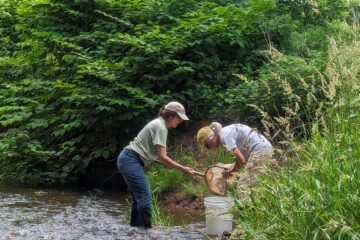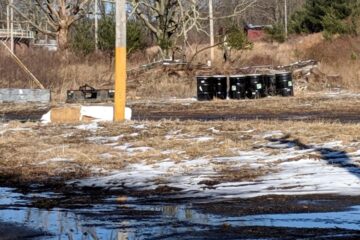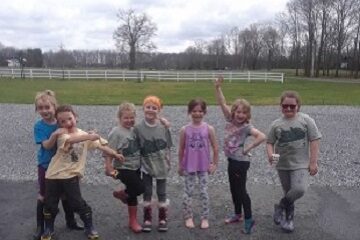Learn how to search for stream critters
Dichotomous Key for Benthic Macroinvertebrates (better for 3rd grade and up)
Key for Benthic Macroinvertebrates (better for younger learners)
A hands-on outdoor activity that helps kids and adults learn how to explore a stream by searching for benthic macroinvertebrates. Created by Debbie Newcomb
Level: All ages
Duration: 30 minutes or more
Setting: Exploration can be done at a small stream or river in your backyard, a local park, or nearby nature center.
Materials
- A pair of old sneakers or water boots
- A kitchen strainer or other net for collecting critters
- Plastic spoon or paintbrush
- Tray or bucket for putting critters in
- Dichotomous key for identification
- Reusable cups (rinsed out applesauce or yogurt cups work well)
- Magnifying glass (helpful, but not required)
Background Information: Rivers and streams provide homes for a variety of organisms including benthic macroinvertebrates which are bottom-dwelling organisms that do not contain backbones and are easy to catch because they are large enough to be seen with your eyes alone. These organisms are able to survive in streams by hiding under rocks, in the mud. and in packs of leaves found at the bottom of the stream. They help break down organic materials and are an important source of food for fish, birds, salamanders and other species that inhabit the stream. Macroinvertebrates are used by scientists to help determine whether a stream is considered healthy or not. Some species can only survive in clean water. By following the easy steps listed below, you can determine the health of the stream in your own backyard or nearby park.
The Activity:
- Fill tray or bucket with an inch or two of clear stream water (be careful to not make the water muddy or it will be difficult to see what is in the bucket). Leave bucket at edge of stream.
- Pick up rocks and turn them over – carefully looking for critters.
- Dig gently in water with kitchen strainer.
- Gently move around rocks, leaves and gravel on the bottom and use strainer to catch anything that floats out from under them.
- Gently remove critters from strainer and place in bucket or cup.
- Observe how the critters behave and any special characteristics they may have. Use the magnifying glass for closer examination.
- Use dichotomous key to help identify what was caught.
- If you have trouble identifying what you have caught, take a picture and upload it to the RHA community learning page and an educator can identify for you.
Wrap-up:
- Return all critters back to the stream very gently and rinse bucket before you leave.
- Ask children what their favorite stream critter was that they found and why.
- Remind children that the critters all serve a purpose and it is our responsibility to take care of the stream and the land that surrounds it.
STEM Challenge (grades 5+): Determine the health of the stream based on the kinds of macroinvertebrates living in the water.
- Tally the number and kinds of macroinvertebrates present in the bucket (use the dichotomous key as a reference guide).
- Based on the classifications, determine which macroinvertebrates are pollution intolerant (Group 1), those able to tolerate a certain amount of pollution (Group 2) and those that are tolerant of pollution (Group 3).
- On the tally sheet, check off the organisms that you were able to identify.
- Determine how many different Group 1 species were collected and multiply that number by 3, determine how many different Group 2 species were collected and multiply that number by 2 and determine how many different Group 1 species were collected and multiply that number by 1. Add the three totals together for a final score (or pollution tolerance index) to determine whether the stream site is considered excellent, good, fair or poor.
- Consider your surroundings. Think about reasons that your stream site may have received a rating of excellent, good, fair or poor. Are there land uses surrounding the stream that may be having a negative or positive effect? Was there any notable pollution or trash in the area? Were there signs of erosion such as exposed roots, bare soil or an excess of sediment in the stream?
- Brainstorm things that you could do to improve the stream site. Tree plantings, stream clean-up, educating others to take care of the site? Remind older children to be good stewards of the environment.
How did you like this activity? Please share any questions, comments, or photos that you and your child have on the Raritan Headwaters Learning Community Facebook Page!
More Raritan Headwaters Learning Resources



